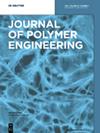A fundamental approach to determine the impact of aramid and carbon fibers on durability and tribological performance of different polymer composites demonstrated in gear transmission process
IF 1.7
4区 工程技术
Q4 POLYMER SCIENCE
引用次数: 0
Abstract
Abstract When selecting a polymer or a reinforced polymer material for a specific drive technology, it is crucial to have a comprehensive understanding of the component’s operating characteristics, including the mechanics of tribological contact and the fatigue life of the materials used in gears. The choice of material plays a pivotal role in the gear running process, as it induces heat generation in the meshing zone and triggers flank wear progression along the high points of the teeth, which directly impacts the gear’s lifetime. This paper presents the results of durability testing conducted on steel/polymer gear pairs. The tested polymer materials were based on polyacetal and polyamide 66 chemical bases, reinforced with aramid, carbon fibers, and internally lubricated with polytetrafluoroethylene. The aim of the study was to evaluate the durability and thermal response of the materials and determine their correlation with flank wear rate progression. The results indicate that gears produced from polyacetal, and carbon-reinforced polyamide 66 materials exhibit the longest durability. Notably, the generated meshing temperatures are closely connected with flank wear propagation. The lowest wear coefficients were observed in gears produced from polyacetal and polyamide 66 materials reinforced with carbon fibers.在齿轮传动过程中,研究了芳纶和碳纤维对不同聚合物复合材料耐久性和摩擦学性能影响的基本方法
在为特定的驱动技术选择聚合物或增强聚合物材料时,对部件的工作特性有一个全面的了解是至关重要的,包括齿轮中使用的摩擦接触力学和材料的疲劳寿命。材料的选择在齿轮运行过程中起着举足轻重的作用,因为它在啮合区产生热量,并触发沿齿的高点侧面磨损的进展,这直接影响齿轮的寿命。本文介绍了对钢/聚合物齿轮副进行耐久性试验的结果。测试的高分子材料以聚缩醛和聚酰胺66化学基为基础,用芳纶和碳纤维增强,内部用聚四氟乙烯润滑。该研究的目的是评估材料的耐久性和热响应,并确定它们与侧面磨损率进展的相关性。结果表明,由聚缩醛和碳增强聚酰胺66材料制成的齿轮具有最长的耐久性。值得注意的是,产生的啮合温度与齿面磨损传播密切相关。用碳纤维增强的聚缩醛和聚酰胺66材料制成的齿轮磨损系数最低。
本文章由计算机程序翻译,如有差异,请以英文原文为准。
求助全文
约1分钟内获得全文
求助全文
来源期刊

Journal of Polymer Engineering
工程技术-高分子科学
CiteScore
3.20
自引率
5.00%
发文量
95
审稿时长
2.5 months
期刊介绍:
Journal of Polymer Engineering publishes reviews, original basic and applied research contributions as well as recent technological developments in polymer engineering. Polymer engineering is a strongly interdisciplinary field and papers published by the journal may span areas such as polymer physics, polymer processing and engineering of polymer-based materials and their applications. The editors and the publisher are committed to high quality standards and rapid handling of the peer review and publication processes.
 求助内容:
求助内容: 应助结果提醒方式:
应助结果提醒方式:


